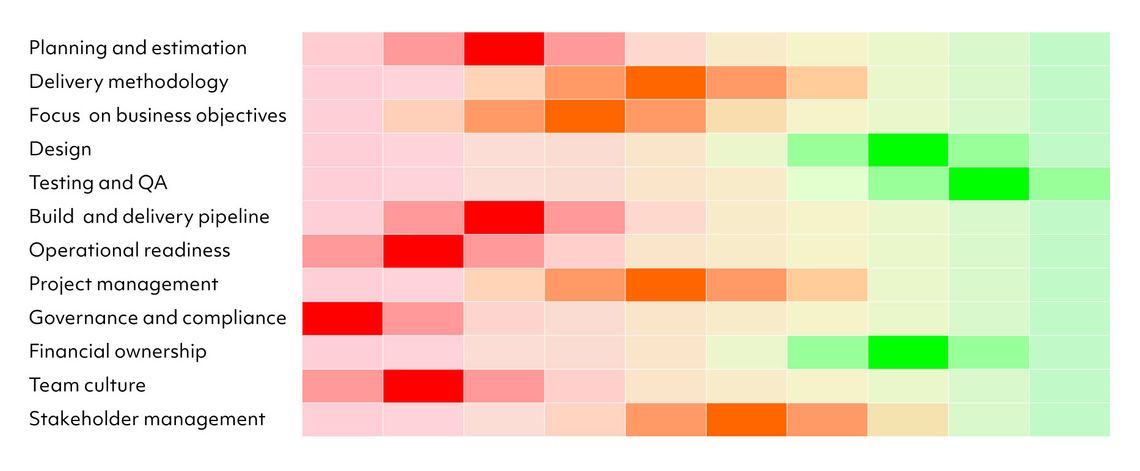An independent review might help get it back on track
According to research by KPMG, an incredible 70% of organisations have suffered at least one project failure in the last 12 months, and 50% of respondents indicated that their projects consistently failed to achieve their core objectives.
When a project goes off the rails, the question becomes how to get delivery back on track, or even whether to cancel the project entirely. Here at Scott Logic, we have many years of experience helping businesses to recover projects and I wanted to share some insights from that experience.
Show leadership rather than passing judgement
When a project goes wrong, emotions are often running high. This calls for a cool but determined leadership style on the part of the reviewer. The reviewer should be impartial and independent enough to be able to build bridges between the different parts of the project. Rather than passing judgement, conclusions should be reached in collaboration with the project team. This becomes especially important at the point of working up recovery options; this needs to be undertaken hand in hand with the sponsor, with appropriate input from the project team.
Focus on the facts
Project recovery demands rapid diagnosis with a structured approach that focuses the project team on the facts. This not only helps the review to avoid becoming embroiled in emotion but also helps get to the real issues quickly. Sometimes, the project team knows what the problems are, sometimes they have a rough idea, and sometimes they prefer to unknowingly hide the facts from themselves. In any case, the reviewer is required to form their own view, on the basis of which to make sound recommendations that will help get delivery back on track.
Use tried-and-tested tools to accelerate diagnosis
It’s helpful to build up a toolkit of diagnostic questions across all areas of delivery, from commercials and relationships, to requirements, architecture and design, all the way through to operational readiness. Such a toolkit can then be used as a starting point from which to tailor the recovery plan, and a baseline from which to visualise recovery progress through rapid heat mapping, informing subsequent diagnosis.

Paint the bigger picture
Diagnosis often means digging deep to get to the root causes. The skill is combining this ability to deep-dive with the ability to develop the holistic picture. Projects that go badly wrong are often complex, and rarely is there just one thing in one area that needs to be fixed. It’s often necessary to call upon wider expertise to address the breadth and depth requirements of the review.
(Re-)Focus on business value
The business value that was the original objective of the project can often be overshadowed and obscured as the focus shifts to the complexities of delivery. When building a recovery plan, it’s critical to focus again on delivering real business value, not simply the perceived solution. By applying this perspective and a degree of rigour, the areas of highest priority will become clear – along with what can be left out. Evidence-Based Management(EBM) is one way to remove some of the emotion from these decisions and help ensure this focus on value.
How Scott Logic can help
What I’ve described above is both an articulation of our combined wisdom about the best approach to project recovery and – consequently – the Scott Logic approach to project recovery.
As I’ve described above, it can often be helpful in these situations to introduce an independent perspective, unencumbered by the project’s history and politics, and immune to the influence of the wearers of rose-tinted spectacles within the team.
Our expert and highly experienced consultants – all permanently employed by Scott Logic – can work in close collaboration with your teams to review your project, shape a recovery plan and help implement it to get your project back on track.
In all our work, we enhance the core strengths of our clients’ technology delivery capability, so we will leave your teams with clear recommendations and sufficient knowledge and understanding to implement these recommendations on future projects.
If you’d like to know more about how we can help you, please email me at matt@scottlogic.com.
A tale of the unexpected
I’ll close by recalling one of the more “intense” reviews I’ve been involved with. It’s an example of how reviewers need to adapt to what they find; sometimes things will go in a very different direction to what is expected.
Here, the business and IT were up against a very demanding regulatory deadline. The board was becoming increasingly sceptical about the ability of the platform to handle the required change. There were growing calls to change direction and replatform the technology. Delivery had not quite gone off the rails, but the CEO recognised that there was a real risk of it doing so. As we got talking, it became clear we would need to look broad and deep to come up with the right recommendations.
As the diagnosis progressed over several weeks, it became increasingly clear that the technology architecture was actually in pretty good shape. The real problems lay with the organisation, which was not set up to cope with the new demands being placed on it. What started as a review of the technology was increasingly becoming a review of how to change the organisation and ways of working to deliver at the new scale.
Our review gave the technology a largely clean bill of health, but delivered some far-reaching recommendations on leadership, sourcing of IT capability and change management processes, all of which were taken on board and subsequently implemented. Two years on, I was part of the team that successfully got this tsunami of regulatory change across the line!
While not necessarily a typical example of project recovery, I hope it provides you with a useful illustration of how a fresh external perspective can help you to see beyond internal biases and zero in on the true causes of a failing project.
Click here to read more about our project recovery approach.


